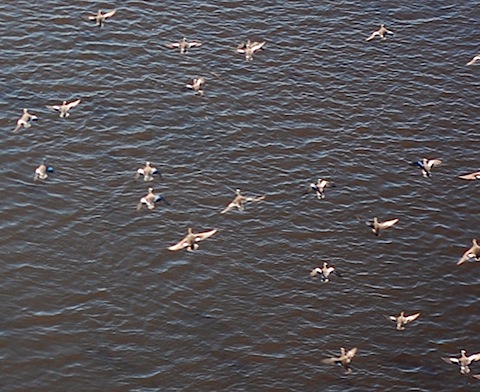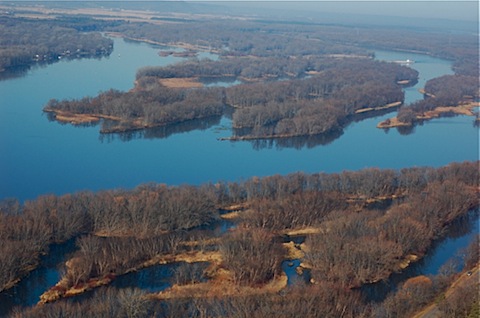 Doing aerial waterfowl surveys is hard work. It's a lot like shorebird identification, you can't just rely on colors, it's more general size, shape and impression--that's right giss birding! I'm told that the hard part for many on these surveys is not getting motion sick in the plane. I can't imagine being motion sick and trying to id and count large amounts of birds literally on the fly. Ick. Fortunately, for me as long as I'm not chugging martinis the night before and if I keep some snacks handy, nausea avoids me. When I first learned that I would be doing these surveys, I was given six hand illustrations of ducks to study and I searched Google Images to find photos of ducks taken from aerial surveys to make flash cards...there aren't too many images like that out there. My hope is that someone who gets to do this in the future, finds this blog entry and has some chance of learning what to watch for the first time they go up. The truth is, nothing really trains you like having an experienced eye with you the first few times you fly to help you learn your birds.
Doing aerial waterfowl surveys is hard work. It's a lot like shorebird identification, you can't just rely on colors, it's more general size, shape and impression--that's right giss birding! I'm told that the hard part for many on these surveys is not getting motion sick in the plane. I can't imagine being motion sick and trying to id and count large amounts of birds literally on the fly. Ick. Fortunately, for me as long as I'm not chugging martinis the night before and if I keep some snacks handy, nausea avoids me. When I first learned that I would be doing these surveys, I was given six hand illustrations of ducks to study and I searched Google Images to find photos of ducks taken from aerial surveys to make flash cards...there aren't too many images like that out there. My hope is that someone who gets to do this in the future, finds this blog entry and has some chance of learning what to watch for the first time they go up. The truth is, nothing really trains you like having an experienced eye with you the first few times you fly to help you learn your birds.
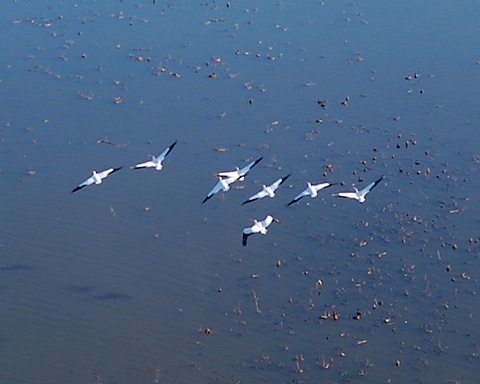
Some birds will be easy to identify on an aerial survey--American white pelicans are huge, fly slowly and are quite distinctive.
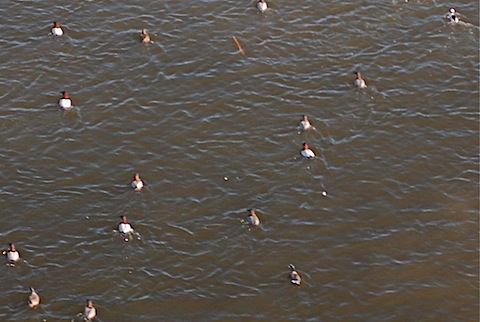
And some ducks are easier to identify than others. Can you pick out the three species of waterfowl above?
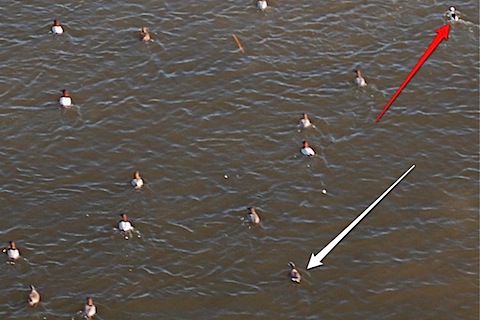
The ones with the prominent white back are canvasbacks. The white arrow points to a bird with a prominent white stripe on its head--that's an American wigeon and then up in the corner is a distinct black and white bird with a bold white patch on the head--that's a bufflehead.

Here's another group that is fairly easy to figure out. Can you name the tree waterfowl species above? The white birds are tundra swans, the medium sized brown birds are Canada geese, and the smallest birds are mallards. You can't see it in the above photo, but the male mallard's green head was easily visible when we were flying this low. Some would ask how we knew these were tundra swans and not trumpeter. The short answer is we don't, but the longer answer is that these swans were in an area that is known to host thousands of tundra swans in November as they stage and feed before flying out to Chesapeake Bay for the winter. Chances are that a handful of trumpeters could be mixed in, but our survey is primarily about general fall usage. There have been a few points along the survey when we've been closer to the Twin Cities, flying over small family groups of swans that I wondered if we were passing trumpeters and I make sure to note that when I turn in my survey sheets. Now that we have such a large population of trumpeters and they stick around in the winter, it's a challenge to tell trumpeters apart from tundras when flying over them in a plane.

Basic waterfowl id isn't the only challenge. Can you see what's wrong in the above photo? Take a look. Here's the answer:
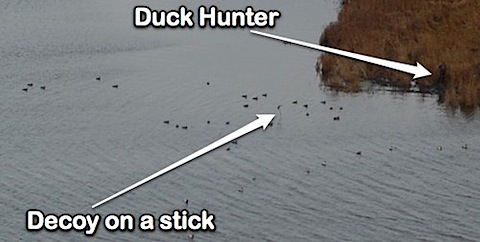
You have to watch closely to make sure that the waterfowl you see are live waterfowl and not a hunter's decoys. The motorized decoys are easy to spot because you start counting and then immediately ask yourself--why is that duck hovering like a hummingbird?
So, these are some of the basic of birds. I'll leave you with a photo that I'll id later. Can you tell what ducks are in the photo below?
